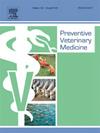Enhancing access to neutering services for dogs and cats in a Brazilian city with a large animal population
IF 2.4
2区 农林科学
Q1 VETERINARY SCIENCES
引用次数: 0
Abstract
In One Health context, ensuring animal access to veterinary services is crucial. Unfortunately, many communities lack such services, highlighting the need for subsidized options. Our study aimed to evaluate free access to the Canine and Feline Surgical Neutering Service in Belo Horizonte, Minas Gerais, Brazil, a city with a large animal population. We also sought to propose actions for enhancing access and develop evaluation indicators. To assess individual access, we employed a logistic model, using service scheduling data from 2012 to 2018. Regional access was evaluated through the Three-Step Floating Catchment Area (3SFCA) method, incorporating data on neutering availability and estimated animal population by Coverage Area for 2012, 2015, and 2018. Our findings indicated that male animal owners were more likely to drop out compared to those with female dogs. Waiting time emerged as a significant obstacle, with an odds ratio of 1.2 per month of waiting, as well as the Health Vulnerability Index (HVI) of the Coverage Area. Although areas of higher vulnerability faced a greater risk of dropouts, we observed "resistance" in these areas, suggesting lower access to private veterinary services for tutors. The spatial access index demonstrated that most areas had a supply capacity exceeding more than 5 %. However, a general reduction in the index occurred in 2018, owing to disproportionate population growth relative to service availability between 2015 and 2018. There was a gradual reduction in inequality in spatial access between areas with different levels of vulnerability, however, areas of very high vulnerability presented significantly lower access than others. Based on our results, we recommend adopting policies that prioritize areas with higher vulnerability, focusing on differentiated supply and waiting time to enhance access. Additionally, identifying the capacity to offer private veterinary services and gathering detailed information on the population dynamics of dogs and cats in the municipality would facilitate a more accurate application of the 3SFCA method in planning neutering services offered by the subsidized veterinary service in Belo Horizonte.
在巴西一个动物数量众多的城市,提高猫狗绝育服务的可及性
在“同一健康”背景下,确保动物获得兽医服务至关重要。不幸的是,许多社区缺乏此类服务,这凸显了补贴选择的必要性。我们的研究旨在评估巴西米纳斯吉拉斯州贝洛奥里藏特市(Belo Horizonte, Minas Gerais)犬猫手术绝育服务的免费准入情况,这是一个拥有大量动物的城市。我们还提出了加强获取和制定评价指标的行动建议。为了评估个人访问,我们使用了一个逻辑模型,使用了2012年至2018年的服务调度数据。通过三步浮动集水区(3SFCA)方法评估区域可及性,结合2012年、2015年和2018年各覆盖区域的绝育可用性和估计动物种群数据。我们的研究结果表明,与养雌性狗的人相比,养雄性狗的人更有可能退出。等待时间成为一个重大障碍,每个月等待时间的优势比为1.2,覆盖地区的健康脆弱性指数(HVI)也是如此。尽管脆弱程度较高的地区面临更大的辍学风险,但我们观察到这些地区存在“阻力”,这表明获得私人兽医辅导服务的机会较低。空间通达指数表明,大部分地区的供给能力超过5% %。然而,由于2015年至2018年期间人口增长与服务供应不成比例,该指数在2018年普遍下降。不同脆弱性地区之间的空间可达性不平等逐渐减少,但高脆弱性地区的空间可达性明显低于其他地区。根据我们的研究结果,我们建议采取优先考虑脆弱性较高地区的政策,重点关注差异化供应和等待时间,以提高获取机会。此外,确定提供私人兽医服务的能力,并收集市政当局猫狗种群动态的详细信息,将有助于更准确地应用3SFCA方法来规划贝洛奥里藏特补贴兽医服务机构提供的绝育服务。
本文章由计算机程序翻译,如有差异,请以英文原文为准。
求助全文
约1分钟内获得全文
求助全文
来源期刊

Preventive veterinary medicine
农林科学-兽医学
CiteScore
5.60
自引率
7.70%
发文量
184
审稿时长
3 months
期刊介绍:
Preventive Veterinary Medicine is one of the leading international resources for scientific reports on animal health programs and preventive veterinary medicine. The journal follows the guidelines for standardizing and strengthening the reporting of biomedical research which are available from the CONSORT, MOOSE, PRISMA, REFLECT, STARD, and STROBE statements. The journal focuses on:
Epidemiology of health events relevant to domestic and wild animals;
Economic impacts of epidemic and endemic animal and zoonotic diseases;
Latest methods and approaches in veterinary epidemiology;
Disease and infection control or eradication measures;
The "One Health" concept and the relationships between veterinary medicine, human health, animal-production systems, and the environment;
Development of new techniques in surveillance systems and diagnosis;
Evaluation and control of diseases in animal populations.
 求助内容:
求助内容: 应助结果提醒方式:
应助结果提醒方式:


